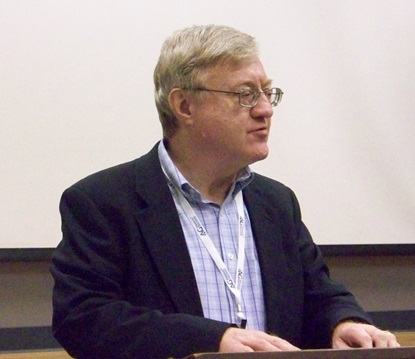Theological Roots of the Word of Faith Movement: New Thought Metaphysics or Classic Faith Movements?
Historian Paul King introduces us to the origins of the controversial Word of Faith movement.

Paul King speaking at the 2014 Society for Pentecostal Studies convention.
A spate of articles and books have appeared over the past two decades debating the controversial teachings of the “Word of Faith” movement. Several blistering critiques such as those of D.R. McConnell (A Different Gospel) and Hank Hanegraaff (Christianity in Crisis) have claimed the movement as heretical or cultic, originating in New Thought metaphysics.1 Others such as William DeArteaga, Joe McIntyre, Derek Vreeland have mounted defenses or reconstructions of modern faith theology, while still others such as Geir Lie, Dale Simmons, and Robert Bowman have presented more moderate critiques and scholarly studies.2
E. W. Kenyon (1867-1948) is generally recognized as the chief originator of the modern faith movement.3 The core of the controversy is found in the purported origins of Kenyon’s teachings. McConnell’s pivotal and influential book entitled A Different Gospel made a case for extensive influence from New Thought metaphysics upon the thinking of Kenyon, detailing noticeable parallels between Kenyon’s writings and New Thought writers. He thus concluded that Kenyon’s thought, and therefore modern faith teaching, is derived from non-Christian cultic sources and thus suspect. Hanegraaff built on McConnell’s research and conclusions to avow further that the modern faith teaching is heretical and cultic. Both books have made a significant impact on the evangelical Christian community in labeling the word of faith movement as heterodox and even sacrilegious.
Are some of the modern faith movement teachings similar to orthodox Christianity and the teaching of classic evangelical writers of faith?
Church historian Eddie Hyatt comments, “These critics … display a lack of knowledge concerning the historical development of the twentieth century Pentecostal movement from its nineteenth century antecedents and its influence of the modern movement. It is in the religious mileau [sic] out of the Holiness and Healing movements of the nineteenth century that the modern “Faith Movement” finds its primary emphasis.”4 Similarly, Simmons’ doctoral dissertation concludes:
As for Kenyon himself, it would appear that he is best placed within the Keswickean/Higher Christian Life tradition. … This is not to say that there are not aspects of Kenyon’s teaching—specifically those centering on one’s confession—that he stresses to a point that is only comparable to that of New Thought. … It would be going too far to conclude that New Thought was the major contributing factor in the initial development of Kenyon’s thought.5
Taking a more scientific approach than McConnell and Hanegraaff, Bowman compared 23 standard New Thought concepts with Christian Science and Kenyon. From this statistical analysis, he concluded that while there is much in common between Christian Science and New Thought, there is “little resemblance” between Kenyon and New Thought. Further, he concluded that Kenyon is “far closer to orthodoxy than is Christian Science.” Kenyon may share some similarity with metaphysical thought, but his views are “fundamentally different.”6 He demonstrates that McConnell’s methodology is faulty, and thus his conclusions regarding Kenyon’s connections with metaphysical New Thought are deeply flawed. While there may have been some metaphysical influence, Kenyon’s views are more unlike such concepts than like.
Category: Church History, Spring 2011


